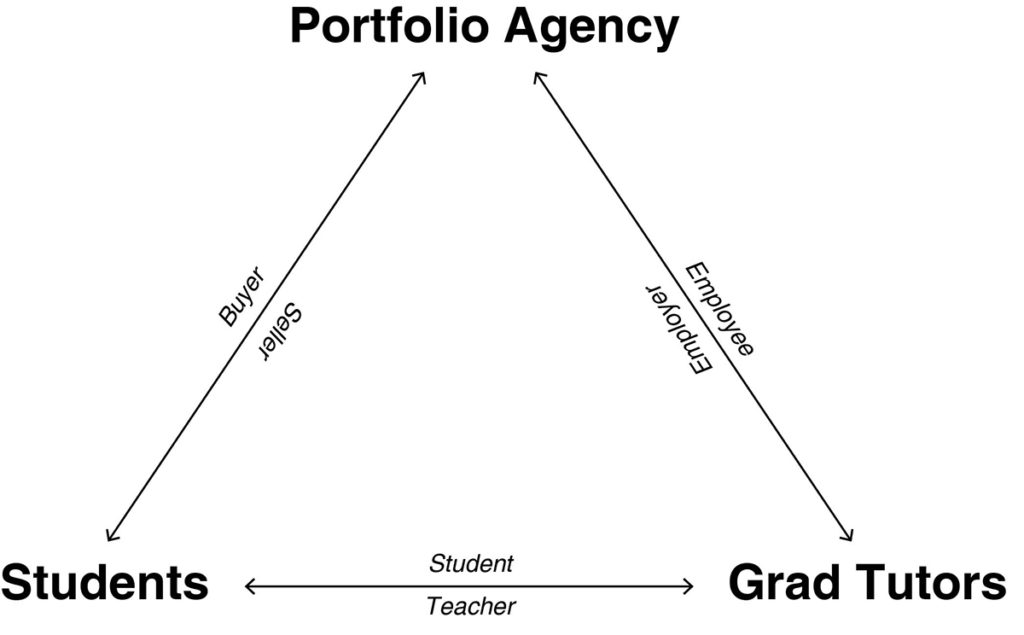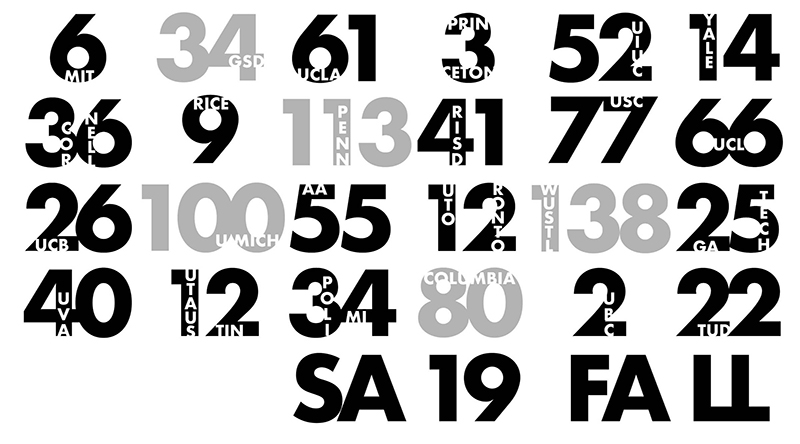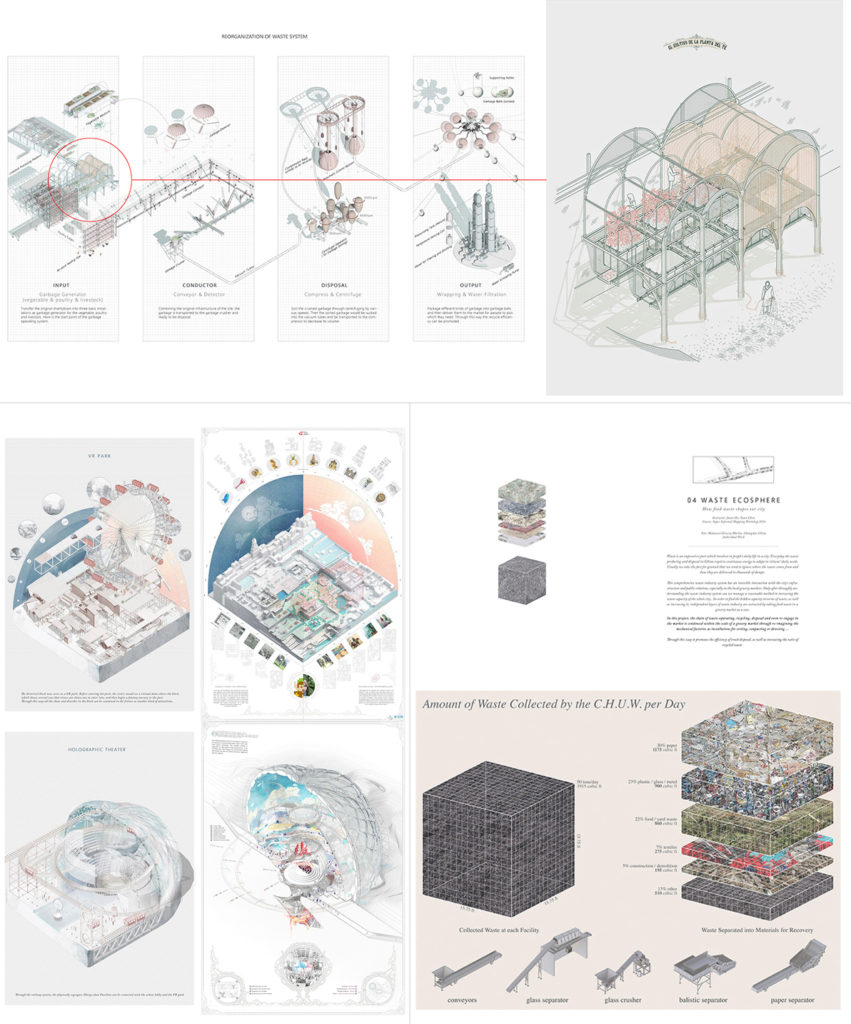
Portfolio Agencies
Zhifei Xu
When one talks about architectural education, one usually discusses it within the institutional framework. Portfolio agencies, on the other hand, although they have many students (clients) and have become an important part of many students’ education, are generally not mentioned, both because they are outside academic institutions and operate somewhat under the table. This article […]
When one talks about architectural education, one usually discusses it within the institutional framework. Portfolio agencies, on the other hand, although they have many students (clients) and have become an important part of many students’ education, are generally not mentioned, both because they are outside academic institutions and operate somewhat under the table. This article is dedicated to these portfolio agencies.
Although portfolio agencies may still be a foreign concept to many in the US or Europe, architecture students1 from Asia who plan to study abroad are usually more than familiar with them. These agencies’ services have almost become a must for applying to architecture schools in the west, and consequently, many complicated issues related to architectural discourse and pedagogy are involved.
A portfolio agency can go by many other names, such as XX Design Tutoring Office, XX Educational Consulting, XX Studio, XX Institute of Design, XX Design Classroom. etc. In fact, the only name they won’t call themselves is XX Portfolio Agency. However, in essence, the purposes of all these businesses are all the same: to improve the quality of portfolios in a short period for the purpose of helping students get into colleges or grad schools.

Three parties in the portfolio market: the buyer (student who wants to apply to western architecture schools), the seller (portfolio agencies), and the actual service provider (grad students or graduates from the top architecture schools, who are employed as portfolio instructors in these agencies, half time or full time.)
Any type of admission rubric will result in people finding ways to cope with that rubric. Colleges in the US require the SAT and GRE for admission, so there are SAT and GRE tutoring services. Similarly, western architecture schools use portfolios as the main selection criteria for admission, so it’s no surprise that portfolio agencies subsequently emerge.
The essence of all the portfolio businesses can be boiled down to profiting from asymmetric information, which in this case, is the formula for producing portfolios targeted at specific schools that reflect the schools’ ideal student types. The admission rubrics necessarily reflect architecture schools’ value judgments, stated another way, what portfolio agencies sell are the unspoken rules within the architecture education bubble.
This is a unique phenomenon in the field of design. You rarely find similar agents focusing on other majors in universities: In those disciplines, a student’s GPA alone is sufficient to prove his/her qualification. Moreover, it’s difficult to coach students on lab experiments or writing journal articles; These are more complicated and lengthy processes. In contrast, portfolio agencies are widespread, largely because the medium for evaluation is different, and images from portfolios don’t always tell the stories accurately. It’s possible to rapidly elevate the quality of a portfolio: A beautiful drawing may come from a year of thinking and hard work, but it can also be a quick mimic completed in just one night.
A typical portfolio consultancy in China costs 9,500 USD (around 60,000 RMB)2. The services portfolio agencies offer disadvantage students who choose to apply on their own (which increases the number of students using them every year), and their high prices make their customers more likely from relatively better-off families. The very existence of the portfolio agencies creates inequity and injustice.
Beyond that, how these portfolio agencies operate is exactly why they are so controversial: Architecture is a creative design discipline, and the portfolio is the self-presentation tool by which the admissions process evaluates the student’s design ability, creativity and endeavor. The main method by which portfolio agencies use to quickly improve the quality of portfolios is through a focus on representation. Portfolio tutors in the agencies are usually graduate students from prestigious architecture schools. They bring in their experience of successful admissions and offer their clients reference projects, drawings, and portfolios from their target schools, and guide the applicants to imitate the style and design.
The portfolio is also used as a way to access the ideas and interests of the prospective student. Yet the agencies help their clients decide on project topics: they would often replicate studios from top schools or suggest topics deemed current and relevant in the institution, resulting in sets of homogeneous portfolios which at the same time feel like a collection of fragmented pieces. If one looks at enough of these portfolios, one can start noticing the similarities. However, this collage approach to creating portfolios has been exceptionally successful in terms of the admission results. Statistically, more and more students are entering top schools through portfolio agencies every year.

This is admission data (2019) for one of the largest portfolio agencies in China, proudly published on their website. Considering the number of Chinese students that the MIT School of Architecture admits every year (about 3-4 in M.Arch Program and around 10 in SMarchS program), six offers in a year is pretty impressive. Note that these are the statistics from only one of these agencies, and there are many others as well (in China and worldwide). Larger schools receive even more students who have benefited from the use of this service. This particular agency got 34 offers from our close neighbor, the Harvard GSD, not to mention Washington University in St. Louis (WUSTL), where the number reached the exaggerated level of 138 offers in a single year (again this is by a single company). Image Credit: http://studioalpha.cn/plus/list.php?tid=43
When design homogenization has developed to the extreme, it can lead to plagiarism. There is no more famous incident than the one that happened in 2018, where a student was accepted to MIT and Yale using one of the largest portfolio agencies in China. Her portfolio agency put images of her portfolio in their promotional article, and then a Princeton alumnus noticed that one of the drawings was originally from a Princeton thesis. Both the student and the agency claimed that the image was only used as source material for the representation purpose and it had nothing to do with the major design concept, stressing that this was within a normal range of referencing in the architectural discipline and therefore should not be considered plagiarism. Because of the sensitive nature of this topic, the story soon hit the headline on Zhihu3 and attracted widespread attention, garnering more than 1.6 million views. Many people outside the architecture community commented that this action should not be excused just because it’s considered as “reference” in the design field; It was clearly plagiarism in those people’s eyes. Indignant architecture students (some of the applicants who got rejected by MIT and Yale) continued looking for images in that student’s portfolio that were similar to the ones on Pinterest. In the end, under numerous reporting letters, MIT and Yale withdrew the student’s offer (this student went to Rice University eventually, because Rice didn’t consider it as plagiarism). Before this incident, portfolio agencies would normally show students’ portfolios and their actual names in their promotion articles to brag about their portfolio “make-up” skills. Since then, the portfolio agencies have become more cautious, choosing to use aliases and not showing their clients’ full portfolios anymore.

Example 1: (above) Image from the controversial portfolio of the student / On the right, Image by Yah-chuenshen, “The Spectacle of Infinite Dimensions”, from AA Diploma 5 Example 2: (left) Image from the controversial portfolio of the student / On the right, Image by Eduardo Tazón Maigre, “BANGLA Pret-a-Porter” Example 3: (right) Image from the controversial portfolio of the student / Below, Image by Debbie Chen, “The Municipal CHUW (Center for Harvesting Utility from Waste)”, from Princeton F’14 Thesis
The portfolio agencies are a product of the marketization of education, architecture schools necessitate and support the market by setting the standards of their ideal candidate, and the reputation and ranking of the schools determine their influence on this market. The schools’ value systems help define the appearance of and the content manufactured by the agencies. Schools which look for skills in graphic representation during admission, will likely get applications from portfolio agencies whose aesthetic is tailored to style, level of detail and look desired. The schools get what they want, the market provides it and the system works. But the question arises: when the admissions process has become a market and a successful portfolio can be bought, the schools seem to lose their abilities to assess the candidates on the terms they purport to.
The portfolio agency has the inherent problems of marketization of education, but it is also in some ways a means of using marketization to address the problem of uneven educational resources. For overseas students, part of the reasons they choose portfolio agencies arise from the differences in education systems. For example, while each school has its own focus, architectural education in China remains largely focused on designing buildings in a rational and cost-effective manner.4 This pedagogy is very much in line with China’s social and economic bases. In contrast, architecture schools in the US are generally more conceptual and experimental in valuing abstract and critical thinking. The “academic architects”, instead of building, tend to shift towards installation, exhibition, curation, which typically belong to the art domain. In recent years, the discourse has become more socially and politically oriented as well. Because having a western educational background is still considered an advantage, many Chinese students are still willing to study abroad to gain a relative advantage in the fierce competition even though there is such a mismatch between the educational systems and the way of practice. For them, portfolio agencies are equivalent to after-school programs, purchased to overcome the mismatch between two educational systems.
Many of those who got accepted through portfolio agencies, even before starting their first classes, start training the next batch of students on how to prepare portfolios. They’ve won their authority from their admissions, now they are trying to earn back the money they handed to the portfolio agencies. But even as portfolio tutors, it’s hard to say that they are the ones who benefit. In some ways, the interests of portfolio agencies and portfolio tutors are at odds: The more successful the portfolio tutors are at their business (lending talent to students who don’t have ideas and skills themselves to pretend as perfect candidates and get accepted into top graduate schools5), the more devalued their own diplomas become. Besides, what is taught in school is of little use in producing (capitalist) value in this capitalist society, also won’t bring them higher paid jobs or more opportunities to get commissions. After they graduate, they find out they actually don’t have that big of an advantage in the job market as they expected, they may understandably choose to earn their money back by training the next batch of international students.
If international students make use of portfolio agencies because of the differences in education systems, then the reason why college students who already study in western architecture schools go to portfolio agencies is more likely because they are not satisfied with the portfolio as the physical manifestation of the education they receive. As portfolio agencies gradually take over some of the school’s educational functions, the school seems to be increasingly reduced to issuers of diplomas.
These agencies exist because we live in a system where anything can be bought, even access to creative education. They exist because the institutions prescribe what is interesting, what the aesthetics of the day are, and what a ‘good’ project looks like.
As long as the portfolios are still used as the primary measure to judge students, portfolio agencies will continue to exist. For now, portfolio agencies earn profit from Asian society’s pursuit of western approaches (including their higher education business) and take a piece of the pie. They might be thought of as mini versions of western architecture schools, but it turns out many of them are larger than some of the US schools.7 Although these portfolio agencies are not as authoritative as the elite schools, they have taken up part of the architecture schools’ responsibilities.
The emergence of so many portfolio agencies seems to have somehow shattered the ”myth“ of architecture schools and their intellectual monopoly. They seem to suggest the possibility of learning architecture without (at least partially) the education institutions. Can these portfolio educations be considered another sense of democratization of education? Portfolio agencies might actually offer us a mirror to reflect on current architecture academia and hint toward a new model of education.
1. There are portfolio agencies for other arts and design disciplines as well. Here we mainly focus on portfolio agencies in the architecture field.
2. Although portfolio agencies in China are used as examples throughout the text, it’s because the writer is from China thus knowing the situation better. As mentioned earlier, portfolio agencies are common throughout Asia, and they exist in the United States as well, and the writer doesn’t want to mislead readers into thinking that this is a China-only issue.
3. The Chinese equivalent of Quora. More discussion (in Chinese) on this can be found on this website: https://www.zhihu.com/question/271911643.
4. Many of the studio projects in studios of Chinese Universities are similar to what students might be doing after they go into practice. These may include residential towers and neighborhoods, community food markets, or focusing on researching a specific kind of architecture (this is more common for upper year students), like transportation, vernacular buildings, high-rise buildings, or green buildings. Besides, Chinese universities require all faculty to have a PhD (compared to US architecture schools, most of the architecture studios are taught by design instructors who hold master of architecture degrees), which also leads to teaching that is more oriented towards research than design.
5. There is a difference between the role of portfolio agencies in undergraduate admissions and graduate admissions. American universities have the flexibility to switch majors at undergraduate level, and schools of architecture are relatively easy to admit in some colleges where they are not considered popular majors. Therefore, there are students who use portfolio agencies to enter a university’s architecture department first, and then transfer to another department after taking general education classes.The portfolio agencies in this case are mainly responsible for helping clients who have never been exposed to architecture to do small projects that will help their acceptance.
6. The largest portfolio agency I’ve seen claims to have 910 instructors on their website. Used for comparison, SOM (one of the US’s largest architecture corporations) (only) has 1000 employees. And then there are others working for lesser-known, small and medium-sized portfolio agencies. Most of the portfolio agencies have their own option studios, and sometimes there are even design-build workshops (you might be able to find more option studios and workshops in a portfolio agency than in MIT every semester). Leaving aside the under-qualified tutors, oftentimes the agency faculty are not very different from American universities. They are graduates (not only Chinese) from prestigious American and European schools who are passing down what they learned and explored in school. Students can also learn a lot if they meet a good teacher. Portfolio agencies also host their own academic lectures and they invite professors from universities all around the world to lead workshops. They also boost camps for improving technical skills or winning competitions and may offer extracurricular activities such as career counseling or company visits. Some portfolio agents have even signed official partnerships with universities such as SCI-Arc (Southern California Institute of Architecture), UAL(University of the Arts London), or IAAC (Institute for Advanced Architecture of Catalonia), helping these schools with recruitments.